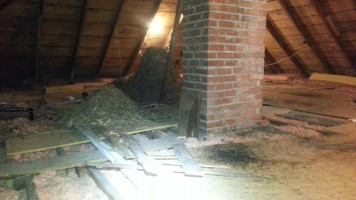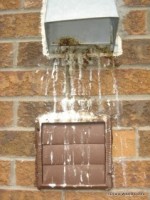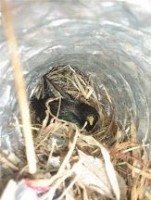When birds of a feather flock together in your home, it can get pretty messy. Pigeons, sparrows and starlings leave behind nests and dropping that can cause serious health problems and frustration for humans forced to share their home with flight of unwanted winged lodgers.
 Warm nest sites like chimneys, attics and vents are prime targets for feathered urbanites. Bird nests with or without birds in them are a health and fire safety problem for your home. Bird droppings are not only unsightly, but birds can also carry mites and parasites into you home.
Warm nest sites like chimneys, attics and vents are prime targets for feathered urbanites. Bird nests with or without birds in them are a health and fire safety problem for your home. Bird droppings are not only unsightly, but birds can also carry mites and parasites into you home.
The Dangers of Bird Droppings
Birds that perch on open chimney flues have a tendency to leave behind unwelcome calling cards: disease-bearing bird droppings in chimney or fireplace. Whether those droppings fall all the way to the floor of your fireplace or remain stuck to the inside walls of your chimney, that bird poop (and any disease-causing spores or bacteria within it) is contaminating the air you breathe.
Pest birds can harbor over 40 types of parasites and host internally 60 types of infectious diseases that can be spread by the dried bird droppings to you, your family, employees and pets.
Exposure to bird roosts and nests that are heavily contaminated with dangerous fungal spores increases the chance of inhalation. Humans are most at risk for infection when dry bird feces become airborne and travel through air vents and opens windows.
- Histoplasmosisis a respiratory disease that may be fatal. It results from a fungus growing in dried bird droppings.
- Cryptococcosisis caused by yeast found in the intestinal tract of pigeons and starlings. The illness often begins as a pulmonary disease and may later affect the central nervous system. Since attics, cupolas, ledges, schools, offices, warehouses, mills, barns, park buildings, signs, etc. are typical roosting and nesting sites, the fungus is apt to found in these areas.
- E coli. Cattle carry E. coli 0157:H7. When birds peck on cow manure, the E. coli go right through the birds and the bird droppings can land on or in a food or water supply.
- Louis Encephalitis, an inflammation of the nervous system, usually causes drowsiness, headache and fever. It may even result in paralysis, coma or death.
Besides being direct carriers of disease, nuisance birds are frequently associated with over 50 kinds of ectoparasites, which can work their way throughout structures to infest and bite humans. About two-thirds of these pests may be detrimental to the general health and well-being of humans and domestic animals. The rest are considered nuisance or incidental pests.
A few examples of ectoparasites include:
- Bed bugs(Cimex lectularius) may consume up to five times their own weight in blood drawn from hosts which include humans and some domestic animals. In any extreme condition, victims may become weak and anemic. Pigeons, starlings and house sparrows are known to carry bed bugs.
- Chicken mites(Dermanyssus gallinae) are known carriers of encephalitis and may also cause fowl mite dermatitis and acariasis. While they subsist on blood drawn from a variety of birds, they may also attack humans. They have been found on pigeons, starlings and house sparrows.
- Yellow mealworms(Tenebrio molitor), perhaps the most common beetle parasites of people in the United States, live in pigeon nests. It is found in grain or grain products, often winding up in breakfast cereals, and may cause intestinal canthariasis and hymenolespiasis.
- West Nile Viruswhile West Nile is technically not transmitted to humans from birds, humans can get infected by the bite of a mosquito that has bitten an infected bird. The obvious lesson is that the fewer birds there are in any given area, the better. This translates into a smaller chance of an infected bird in that area, a smaller chance of a mosquito biting an infected bird and then biting a human.
Birds and Fire Hazards
During the first cold snap in the fall, everyone lights up the first fire of the season. If the flue has not been checked, a hot ember can be carried up the thermal column in the flue and land in the flammable nesting material. The burning nest can either burn out harmlessly or fall onto your roof or into the combustible chase, or through an opening in your attic, causing a major fire.
Bird nests inside vents and attics represent a significant fire hazard. Clogged bathroom and stove vents will fail to exhaust properly causing fan motors to overheat. Dried leaves, twigs, grass and feathers serve as dangerous fire accelerants when placed in contact with a home’s electrical components.
It is important to have your chimney flue checked prior to the first ignition of your fireplace for the winter season. In order to prevent birds from roosting and nesting in your fireplace throughout the year, bird deterrents may be a viable option.
Birds and Stains
Pigeon, starling and sparrow droppings contain high amounts of corrosive uric acid that can stain and damage building materials. If birds are roosting in or on your home, it takes little time for their droppings accumulate on siding, brick, metal and stone. If left too long, bird feces can cause irreversible damage resulting in costly repairs. The easiest way to prevent damage to your home is to quickly remove, exclude and deter birds from your property.
 Dealing with birds is messy business. If there is an accumulation of bird droppings in chimney, attic or storage shed, it’s best to call in a professional who has the equipment necessary for safely removing the droppings.
Dealing with birds is messy business. If there is an accumulation of bird droppings in chimney, attic or storage shed, it’s best to call in a professional who has the equipment necessary for safely removing the droppings.
Skedaddle Humane Wildlife Control suggests you leave the birds and cleanup to us. Call us to find out how we can remove the birds and clean up their mess, so your home, family and pets are safe! 1-888-592-0387.
Proudly serving: Ottawa, Montreal, Halifax, Hamilton, Burlington, Oakville, Mississauga, Brampton, Kitchener-Waterloo, Guelph, Cambridge and the Niagara Region.



